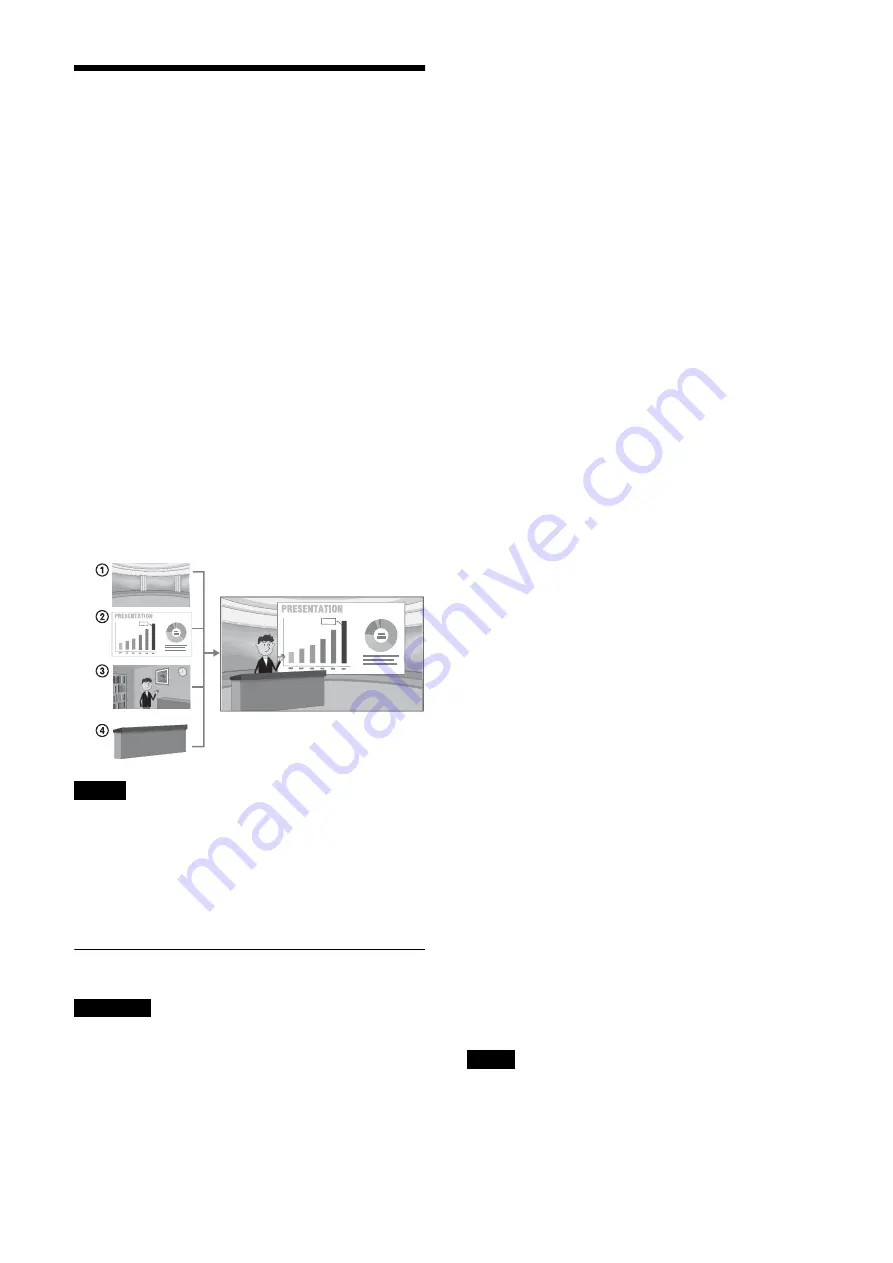
43
Chroma key-less CG
Overlay Application
This application allows you to overlay CG effects in
real-time without using a dedicated studio.
This allows you to select an image or presentation
content for the background of the image.
The Chroma key-less CG Overlay application can
overlay up to four layers of still images or video for
display.
The layers are set in the following order.
1
Background image layer:
Layer for an image input from HDMI IN 2, a built-in
background image, or a PNG background image
uploaded into the unit.
2
HDMI IN 2 input layer:
Layer for an image input from HDMI IN 2.
* Not configurable if the image input from HDMI IN
2 is used on layer
1
.
3
HDMI IN 1 input layer:
Layer for an image input from HDMI IN 1.
4
Foreground image layer:
Layer for a PNG foreground image uploaded into the
unit.
• The Chroma key-less CG Overlay option function
must be enabled before configuring or running the
Chroma key-less CG Overlay application. Activate
the corresponding pre-installed license, or purchase
and install a license.
• A crisp composite image may not always be possible,
depending on the shooting environment.
Preparation before setup
Adjust the focus, white balance, and exposure of the
camera connected to the HDMI IN 1 connector
manually.
1
Check that the following preparations are in
place.
Shooting environment
During shooting, keep the lighting constant so that
the shooting environment does not change, and
mount the camera securely.
The image from the HDMI IN 1 connector camera
is stored in the unit when the application is run (or
when the [Background Refresh] button is pressed).
The unit uses AI to recognize the difference
between the stored image and the current image
from the camera for compositing. Accordingly, the
less the shooting environment changes, the more
accurate the compositing can be achieved.
* Refrain from adjusting the lighting according to
the movement of the person or using a projector in
the vicinity of the person.
Lighting from the front
If a shadow is created on the wall due to strong
lighting from the front, there will be a difference
from the background before the lighting, and the
background wall may show through in the form of a
shadow. When using strong lighting other than
room lighting, such as tripod stand lighting, reflect
the lighting off the floor or ceiling so that it does not
hit the wall directly.
Clothing
Avoid wearing clothing that is the same color or
similar color to the color of the background wall or
other surfaces. Doing so will not achieve an
appealing composite result. When shooting in a
room with walls that are white or a pale color, you
can obtain more detailed compositing content by
wearing clothing with distinguishable colors.
2
Connect a camera to the HDMI IN 1
connector, and connect a computer or
video device to the HDMI IN 2 connector.
3
Connect video output devices to the HDMI
OUT 1 and HDMI OUT 2 connectors.
The composite image is output to the HDMI OUT 1
and HDMI OUT 2 connectors.
When using the RTMP streaming function, the same
video as the output on HDMI OUT 1 is streamed to
a streaming service via LAN cable. When using the
RTMP streaming function, set [HDMI OUT 1] as
the output device for the destination in [Streaming
Output 1] on the [Codec] tab (page 23).
4
Turn on the camera and peripheral devices.
Make sure that objects that move (such as fans, curtains,
and objects visible through windows) do not come
within the angle of view of the camera connected to the
HDMI IN 1 connector.
Notes
Important
Note





























